South Shields Corporation Tramways
History
South Shields Corporation obtained powers to construct a standard-gauge horse tramway within the town on the 18th July 1881. Under the Tramways Act of 1870, the corporation were however not permitted to operate the tramway themselves, so it was leased to a Mr Winby, who set up a company — the South Shields Tramways Company — to work the tramway.
Unfortunately, and before construction began, the corporation inadvisedly changed the gauge of the tramway to 3ft 6ins, a move that was to put them on a collision course with the Board of Trade, who quite naturally refused to approve a tramway which so obviously contravened the parliamentary order under which it had been constructed. This was to cost the council time and money — whilst it sought a second order — all due to an unapproved change of gauge that a couple of minutes with a legal professional could have obviated. Although the council naturally sought to divert blame, claiming Mr Winby had advised them to change the gauge, there is more than a hint of parochialism to the decision, a 3ft 6ins-gauge tramway making it much harder for other contemporary tramway proposals, which were all standard gauge, to encroach upon the corporation's territory.
The tramway finally opened for business on the 1st August 1883, around nine months later than it otherwise would have done had the gauge not been changed. The line ran from Slake Terrace at Tyne Dock in the west, snaking eastwards and northwards through High Shields and Milldam to the Market Place, before turning eastwards along King St and Ocean Rd to the eastern terminus at the Pier Head; although various extensions were planned, none were ever built, the system's final size being 2.53 miles.
Although the tramway ran successfully for over two years, the corporation's woes were not yet over. The SSTCo had unfortunately agreed an unrealistically high rental with the corporation, and could thus not make the concern pay, eventually being pursued for non-payment of interest and loans by its debenture holders. Whilst the latter were initially persuaded to hold off taking legal action in the hope of transferring the assets to a new lessee, the corporation was taken completely by surprise on the 30th April 1886, when services abruptly ceased. The tramcars and horses were removed in the dead of night and then sold off — presumably by a receiver or liquidator — the corporation being left with the tramway tracks and depot (which it of course owned) but no means of operating the concern.
Eventually, Daniel Busby and William Turton came to the rescue, two well-known tramway entrepreneurs, who either separately or together had interests in several horse tramways in the north of England, most notably, those of Newcastle, Manchester, Leeds, Liverpool and Salford. They formed a new company to work the tramway — the South Shields Tramways and Carriage Company Limited — which re-opened on the 28th March 1887 after almost a year lying dormant.
Happily for the corporation, Busby and Turton knew what they were doing, and with a more realistic rental, turned the tramway into a profitable concern, which they expanded through the introduction of horse omnibuses. In the late 1890s, the success of the tramway attracted the attention of the British Electric Traction Company Limited, which had, since the mid-1890s, been aggressively purchasing horse and steam-operated tramways across the British Isles with the intention of converting them to electric traction, as well as promoting schemes for completely new electric tramways. The BETCo had grand plans to build a tramway network south of the Tyne, stretching from Gateshead eastwards through Hebburn and Jarrow to South Shields, then south to Sunderland, and as part of this, it acquired the SST&CCo (in July 1899), followed a few months later by the Gateshead and District Tramways Company (a steam tramway). Powers were also acquired — on the 17th December 1901 — to construct tramways in Jarrow, which was immediately to the west of South Shields.
Unfortunately for the BETCo, their plans to construct tramways southwards to Sunderland ran into significant opposition from Sunderland Corporation, the North Eastern Railway Company and South Shields Corporation, the latter having held powers to convert their horse tramway to mechanical traction since July 1896. Although the company did not give up, trying a second time to obtain approval, the objections once again resulted in the application for a Light Railway Order being rejected. Whilst the company still hoped to persuade the corporation to lease them whatever system it decided to build, they must have realised that the chances were slim when the corporation gained additional powers in 1903, not only for extensions, but also to operate the system itself.
Construction of the corporation's, standard-gauge, overhead electric tramway commenced on the 6th June 1905, the SST&CCo's lease terminating on the 1st February 1906; all tramway and omnibus services ceased the day before, with the first electric service commencing two months later on the 30th March 1906.
The system was opened in stages over the next 12 months, after which there was only one major extension (of circa 1.25 miles in 1922), which took the system to its final size of 7.51 miles. The core of the system was a figure of eight, with the northern apex at the junction of King St, Mile End Rd, Ocean Rd and Fowler St, and the southwestern apex at Tyne Dock. From the northern apex, a line ran southwards to Westoe, where it turned southwestwards along Dean Rd and Stanhope Rd to Bolden Lane, then northwestwards along Hudson St to Tyne Dock. The return route ran northwards along South Eldon St, Frederick St and Station Rd to the Market Place, where it turned northeastwards along King St to the northern apex. The middle of the figure of eight ran along Laygate. The remainder of the system comprised three branches, two running from the northern apex — one northwards for a short distance along Mile End Rd, and the other northwestwards along Ocean Rd to the South Pier — and the last line, built in 1922, running southwards from Westoe along King George Rd to Cleadon, terminating just beyond its junction with The Ridgeway. The latter was just over two miles from the nearest Sunderland Corporation Tramways line, but the two systems were never joined up, in no small part due to the intransigence of the council, who who refused to entertain any connecting route other than the one they proposed.
At Tyne Dock, the tracks and overhead were connected to those of the Jarrow and District Electric Traction Company, which was a subsidiary of the BETCo. Although through-running was eventually agreed in 1908, it was terminated three years later after the corporation demanded more money for J&DETCo cars working over its lines, and though the company offered to meet them half way, the corporation refused. Whatever the corporation said publicly about making a loss on the service, it was fairly clear that many within the council were ideologically opposed to a company making money in their area, even if it were mutually beneficial; it was of course the travelling public who paid the price for the council's dogma. In the 1920s, after years of public complaint, through-running was restored, but only for around 5 years, before the corporation once again pulled the plug; during this period, cars of the J&DETCo travelled through to the Pier Head, whilst those of the corporation ran through to Jarrow.
The corporation looked at building various extensions shortly before the Great War, but was unsure whether they could be made to pay, so instead opted for a small number of battery-electric buses. This decision was in part driven by the activities of a new bus company — the Northern General Transport Company — which began encroaching into what the corporation saw as its territory. To add insult to injury, the NGTCo was a subsidiary of the BETCo, the root of all evil as far as the corporation were concerned. These buses appear to have served the corporation well during the war years, being immune to War Department requisition and independent of restrictions on imported fuel.
Like most tramway systems nationally, the SSCT was placed under immense strain during the Great War, with greatly increased passenger loadings, severe shortages of staff, and restrictions on spares and new material. As a result, the tramway emerged from the conflict in badly run-down condition, with a significant maintenance backlog and an ageing tramcar fleet. The corporation however, still viewed the tramway as the core of its transport services, constructing a new double-track, reserved-formation tramway out to a large new housing estate in Cleadon (opening in 1922), ensuring that the tramway could continue to serve the needs of the populace as it migrated outwards from the centre of the town. The corporation's enlightened approach to its tramway also saw it invest in new tramcars in the early 1920s, and a series of second-hand vehicles — between 1929 and 1930 — from tramways that were closing; it also undertook a sizeable rebuilding programme that saw some cars emerge as virtually new vehicles. The last new tramcar of all was purchased in 1936, and though thoroughly modern, the corporation had by the time of its arrival, already made the decision to switch to trolleybuses.
Up until the 1920s, the tramway was very profitable, often making substantial contributions to the rates, despite paying an exorbitant price for current and thus subsidising the struggling corporation electricity department. By the early 1920s, the post-war boom was over, economic recession and higher costs had turned the profits into small losses, matters being made worse by the handful of corporation buses — which it had been operating since 1919 — which were being subjected to intense competition from pirate operators, and were making a substantial loss. The economic situation worsened significantly in the second half of the 1920s, and with passenger numbers dropping, by the early 1930s, the undertaking was making an annual loss. This was a prelude to an extraordinary period in 1933/1934, when the council effectively declared war on its own tramways department; the latter was accused of all kinds of misdemeanours, the council setting up a Special Committee to investigate, one which had no independent tramway expert. The process was conducted quite publicly, so it is fairly clear that those holding the reins of power had an axe to grind, a view supported by the outcome, which basically found some minor shortcomings, but then saw fit to censure several individuals, either forcing their retirement or demoting them. Whatever the rights or wrongs of this, it resulted in a series of new managers and a change in direction.
Although a new manager was appointed in April 1934, the council clearly thought it knew how to run a tramway better than the manager and the Tramways Committee, forcing the latter (against its wishes) to replace the entire track on the Ocean Rd line, a significant outlay for a branch line that only made money on summer weekends. The new manager, who was eventually to become the General Manager of Glasgow Corporation Transport Department, only stayed for a short time, but left his mark by persuading the council to order new buses, and to seek powers to operate trolleybuses — granted on the 2nd August 1935 — and to abandon the tramway system. At the same meeting, in June 1934, it was decided to change the name of the undertaking to South Shields Corporation Transport Department.
The first trolleybus entered service on the 12th October 1936, being initially deployed on new routes rather than as a tramway replacement service. The first tramway replacement came on the 3rd May 1937 (Market Place to Stanhope Rd), by which time the SSCT had managed to lose yet another manager. In a quite bizarre spectacle, the council chose to celebrate the conversion of the town routes — essentially the figure of eight — to trolleybus operation (in 1938) by burning a tram, an act which perfectly sums up the council's attitude to its tramway.
This left just one tramway route operating — Moon St to Ridgeway — which was given a reprieve by the outbreak of the Second World War, but which finally closed on the 31st March 1946.
Uniforms
Although South Shields' horse tramway system was built and owned by the corporation, it never actually operated the services itself, instead leasing them to operating companies. The first of these was the South Shields Tramways Company (1883-1886), about which very little is known, with not even a single photograph having survived for posterity. It does however seem likely that the company followed the general practice of most horse-tramway companies in not issuing uniforms, so in probability, staff would simply have worn informal attire, such as heavy jackets and overcoats, along with the fashionable head gear of the day (during this period, almost certainly the bowler hat).
In contrast to the above, photos of the subsequent South Shields Tramways and Carriage Company era (1887-1889) have survived in significant numbers, and clearly show that staff wore a variety of informal attire such as jackets, shirts and ties, heavy overcoats (particularly drivers), along with top hats, bowlers hats and tight fitting flat caps. No insignia of any kind, badges or licences, were worn.
Following the British Electric Traction Company takeover of 1899, staff were issued with uniforms: conductors wore single-breasted jackets with five buttons and upright collars, whilst drivers appear to have worn double-breasted jackets with lapels. Neither style of jacket appears to have borne insignia of any kind. Caps were initially in a kepi style with a glossy peak, but did not at first carry a cap badge. At some point, it isn't exactly clear when, the kepis were superseded by soft-topped military-style caps with glossy peaks; these now bore a cap badge, possibly an employee number, though there remains a possibility that it was the standard BETCo 'Magnet & Wheel' badge (see below). The BETCo usually reserved its 'Magnet & Wheel' branding for its new electric tramways, though it definitely issued 'Magnet & Wheel' cap badges for a time on another of its horse tramways —the Brighton and Shoreham Tramway — certainly to the inspector, and possibly to tramcar staff too.
Horse tram drivers and conductors were also issued with double-breasted greatcoats with five pairs of buttons and high fold-over collars; the latter appear to have been left plain.
Early photos of the corporation-operated electric era show that crews were issued with double-breasted, lancer-style tunics with five pairs of buttons (narrowing from top to bottom, and presumably brass — see link) and upright collars; the latter probably bore an employee number on the left-hand side, and individual metal initials — S S C T — on the right-hand side. Caps were in a military style with a wide tensioned crown (top), and carried script-lettering grade badges, either Conductor or Motorman; these were presumably in brass to match the buttons. In the late Edwardian era, the script-lettering grade badges were supplemented with a round cap badge containing the municipal coat of arms (see below); this new badge eventually replaced the script-lettering grade badges completely around the time of the Great War.
In later years, conductors were issued with single-breasted tunics with five buttons, breast pockets, epaulettes and upright collars, whilst motormen continued to wear 'lancer-style' tunics right through to closure. It is possible, but by no means certain that the buttons and badges were changed to nickel at this time.
The tunics were also augmented with epaulettes at some point (these were fastened with a button at the neck end, but were otherwise devoid of insignia), and the caps, though still military in style, later on had a soft top rather than a tensioned crown (top).
Perhaps unsurprisingly, given South Shields location on the North Sea, many photos show staff wearing double-breasted greatcoats with five pairs of buttons and high fold-over collars; like the tunics worn underneath, the collars bore an employee number on the left-hand side and individual metal initials — S S C T — on the right-hand side. In later years, the greatcoats bore epaulettes.
As far as senior staff are concerned, numerous photographs of the SST&CCo have survived, but none show inspectors, so it could well be that the company did not see fit to employ them.
In the early electric era, inspectors wore single-breasted jackets with hidden buttons (or more likely a hook and eye affair), four slit pockets and upright collars (see below); the pockets and the jacket were edged in a finer material than the main body. The collars probably carried the designation Inspector on the bearer's right-hand side and system initials — S S C T — on the left-hand side, in embroidered script lettering, though these cannot be made out with certainty on surviving photographs. Caps were initially in a kepi style with a pom pom on top, and carried the designation Inspector, probably in embroidered script lettering on a hat band. At some point, a switch was made to military-style caps with tensioned crowns (tops); these simply bore the standard, round municipal arms badge, seemingly without a grade badge. The jackets were also subtly changed in later years, bearing breast pockets with flap closures rather than slit pockets.
The Chief Inspector (see below) wore a very similar uniform to the inspectors, but with braided epaulettes. The collar insignia almost certainly reflected his grade, though this cannot be made out on the surviving photograph. Like the inspectors, his cap simply bore the standard South Shields Corporation Tramways cap badge.
In common with many tramway systems, conductresses were employed during the Great War to replace men lost to the armed services. Only a single photograph of these ladies has so far come to light; all the subjects are wearing long, double-breasted topcoats (with four pairs of buttons) with epaulettes and high fold-over collars, along with shiny, waterproof bonnets, the latter possibly for winter wear. The only badges worn appear to have been on the collars, possibly employee numbers, though this is far from clear. The conductresses were presumably also issued with uniform jackets and some form of cloth cap/hat for summer wear. Contemporary comment suggests that the jackets were three-quarter length, and that gaiters were also worn.
In 1914, South Shields Corporation Tramways Traffic Department employed 1 Chief Inspector, 4 Inspectors, 39 Motormen, 51 Conductors and 9 Points Boys (see ‘The Tramways of Jarrow and South Shields’; George S Hearse, 1971).
Further reading
For a history of South Shields tramways, see: 'The Tramways of Jarrow and South Shields' by George S Hearse; published by the author (1971).
Images
Horse tram drivers and conductors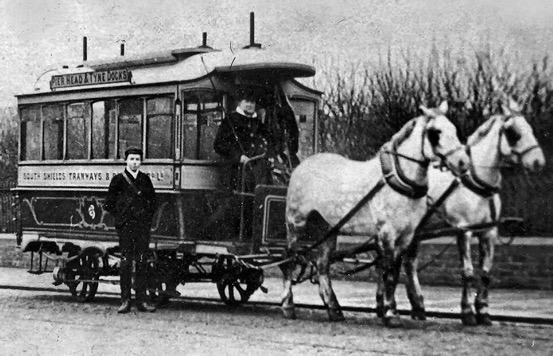
A rather new-looking Horsecar No 6 at Bents Park — photo undated, but possibly taken around 1890 when these Ashburys-built vehicles were first put into service. The driver is wearing typical coaching gear, i.e., a coachman's coat and a top hat; the conductor on the other hand is wearing an informal single-breasted jacket and a tight-fitting flat cap. With thanks to Malcolm Fraser.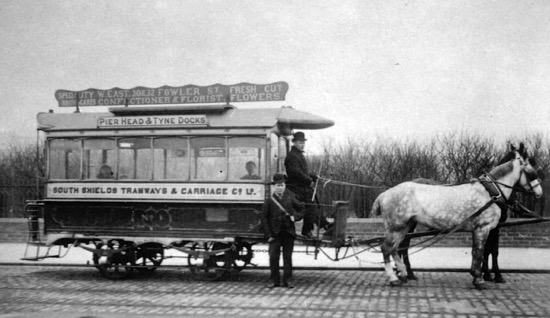
Horsecar No 1, another Ashburys-built single decker, and again captured at Bents Park — photo undated, but probably taken around 1890. Both men are wearing the tall bowlers typical of the period. Photo courtesy of the Tramways and Light Railway Society, with thanks to David Voice. 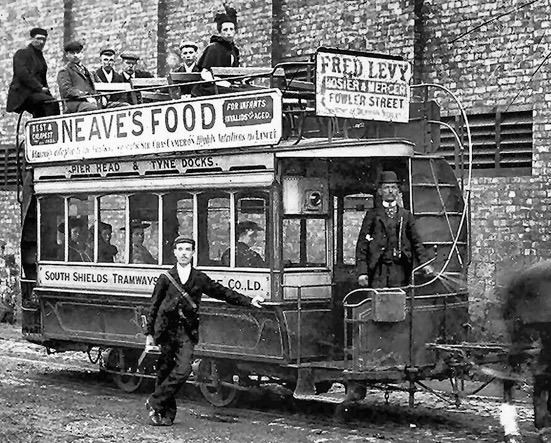
Horsecar No 10 (a product of G F Milnes) stands at Tyne Dock — photo undated, but probably taken around 1894. Both the driver and conductor are wearing informal attire, the former in a bowler hat and the latter in a flat cap. The conductor is holding a Kayes Patent fare collection box in his right hand. With thanks to Malcolm Fraser.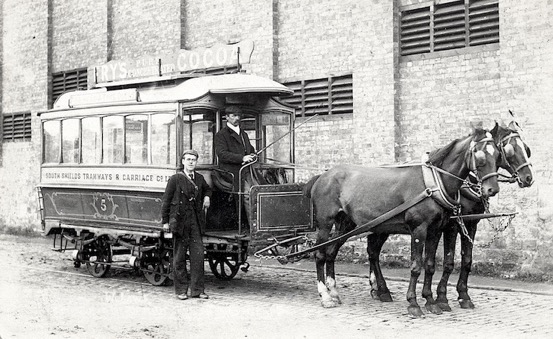
Another shot taken at Tyne Dock, this time of Horsecar No 5 — photo undated, but probably taken in the mid-1890s. Both men are wearing informal attire and flat caps. Photo courtesy of the Tramways and Light Railway Society, with thanks to David Voice. 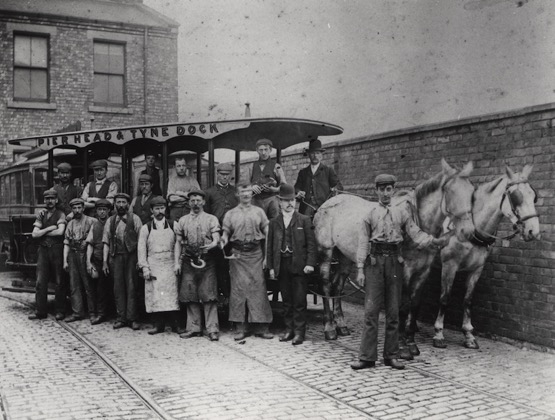
A superb shot taken in Victoria Rd depot with a toastrack horse car, showing fitters, farriers, stablehands and presumably, the odd driver and conductor — photo undated, but probably taken in the early-to-mid 1890s. No-one present is wearing a uniform. The SST&CCo had a number of toastracks, and you have to admire the optimism of the company given South Shields exposed position on the North Sea coast. Photo courtesy of the Tramways and Light Railway Society, with thanks to David Voice.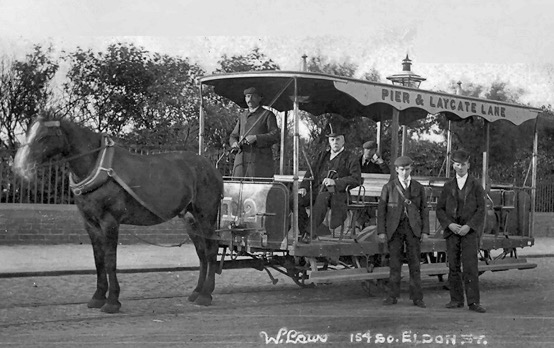
Horsecar No 12, a toastrack, stands at Bents Park with a Pier to Laygate Lane service — photo undated, but probably taken in the mid 1890s. Both the driver and conductor are wearing informal attire, and there is no sign of insignia, either badges or licences. Photo by W Laws, with thanks to Malcolm Fraser.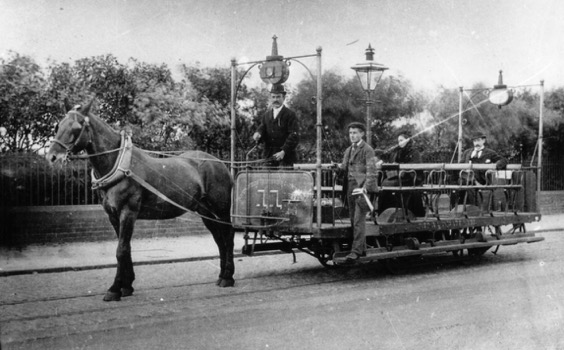
Another shot of a toastrack at Bents Lane, this time No 11, which though quite elaborate, could clearly do with a lick of paint, suggesting that the photograph was taken in the late 1890s. Photo courtesy of the Tramways and Light Railway Society, with thanks to David Voice.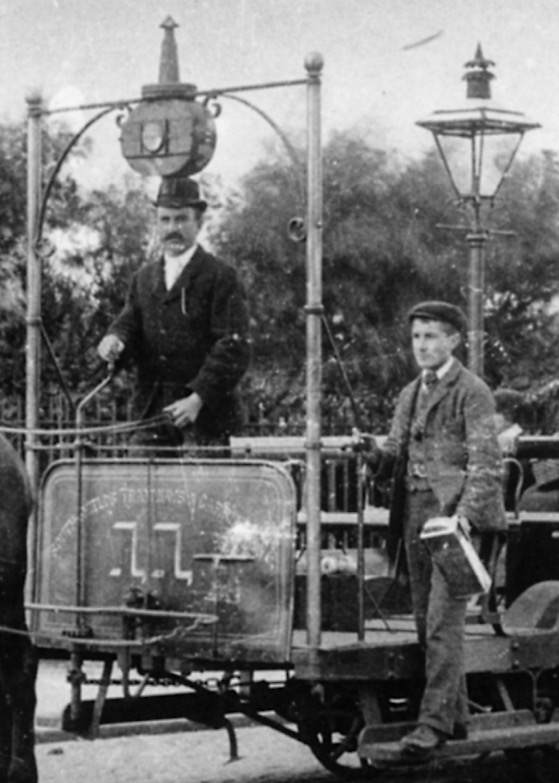
A blow-up of the above photo showing the driver and conductor, the latter with a Kayes Patent fare collection box.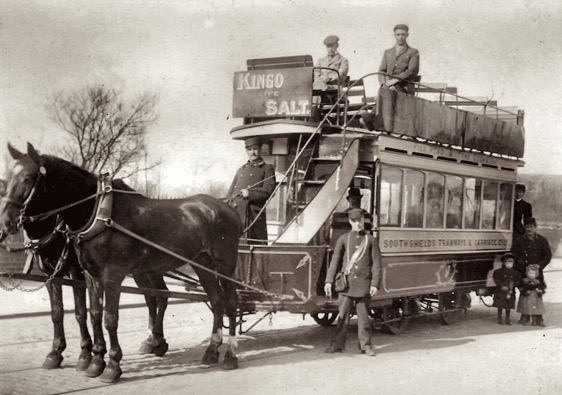
Horsecar No 9 captured at Bents Park — photo undated, but probably taken shortly after the British Electric Traction Company takeover of 1899. With thanks to Malcolm Fraser.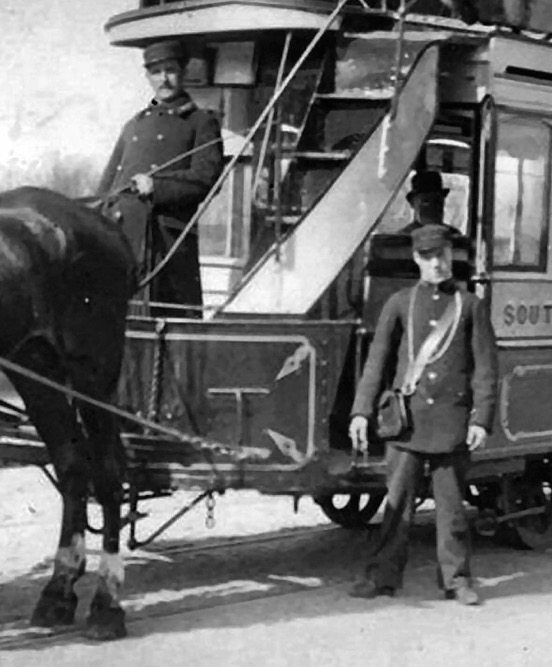
A blow-up of the above photo showing the driver and conductor, both of whom are wearing uniforms with kepi-style caps. Neither the collars nor the caps would appear to carry insignia.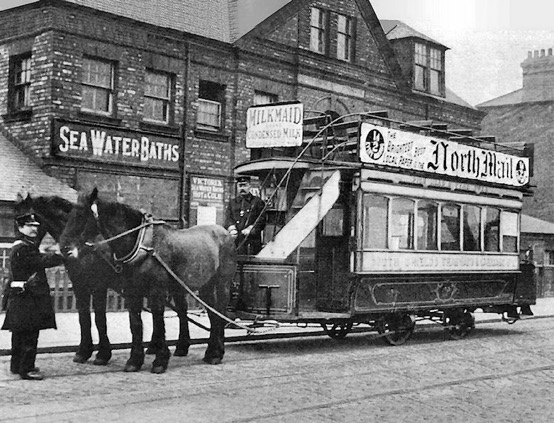
Horsecar No 8 standing in front of the Sea Water Baths at Pier Parade — photo undated, but possibly taken in 1905. With thanks to Malcolm Fraser.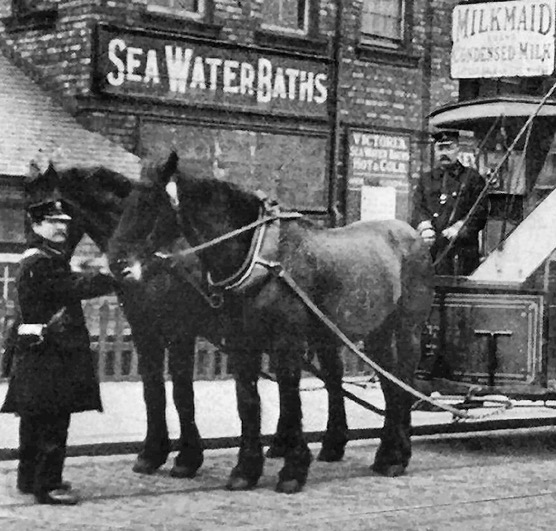
A blow-up of the above photo showing the conductor and driver, both of whom are wearing greatcoats — photo undated, but possibly taken in 1905. Both men are wearing soft-topped, military style caps which carry a metal cap badge, probably an employee number, though it may be the standard BETCo 'Magnet & Wheel' cap badge.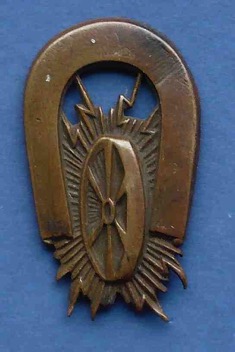
Standard British Electric Traction Company ‘Magnet & Wheel’ cap badge — brass. It seems unlikely that staff were issued with this badge, as the BETCo generally only introduced them following electrification; it remains however, a possibility.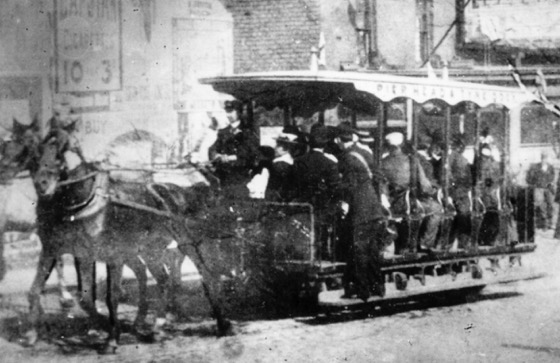
A poor quality photo of a South Shields toastrack, but one which does show a driver in double-breasted uniform jacket with lapels — photo undated, but certainly taken between 1899 and 1906. Photo courtesy of the Tramways and Light Railway Society, with thanks to David Voice.
Motormen and conductors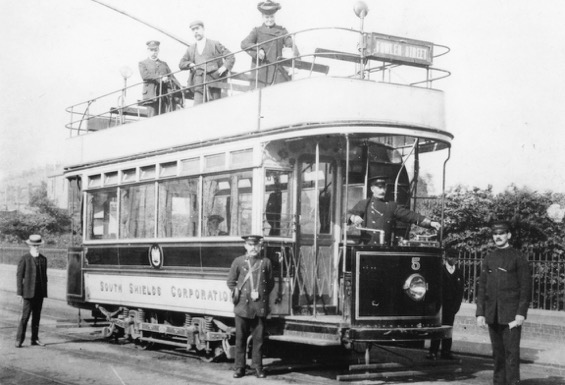
A conductor, motorman and an inspector pose with Tramcar No 5 (very probably brand new) at West Park in Stanhope Rd, with a service bound for Fowler St — photo taken in the summer 1906. With thanks to Malcolm Fraser.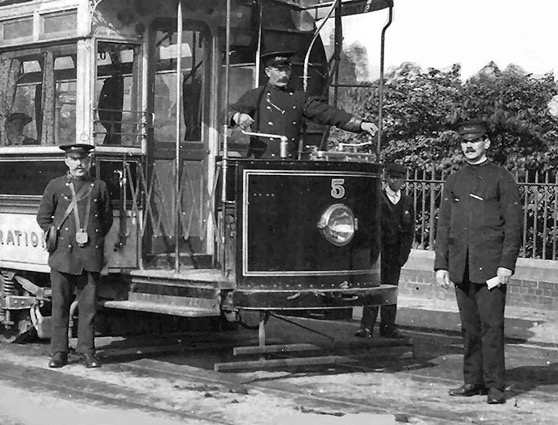
A blow-up of the above photo showing the tramwaymen, the crew in 'lancer-style' tunics with military-style caps, and the inspector in a single-breasted jacket with a kepi-style cap topped by a pom pom. The conductor's and motorman's caps bear script-lettering grade badges.
Standard script-lettering cap badges of the type used by South Shields from the start of electric services in 1906 up until around the time of the Great War — brass. Author's Collection.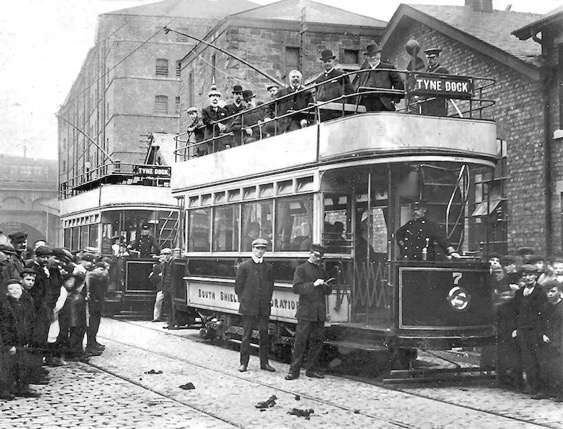
Tramcar No 7 captured at Slake Terrace, Tyne Dock on the opening day of that route — 23rd June 1906. With thanks to Malcolm Fraser.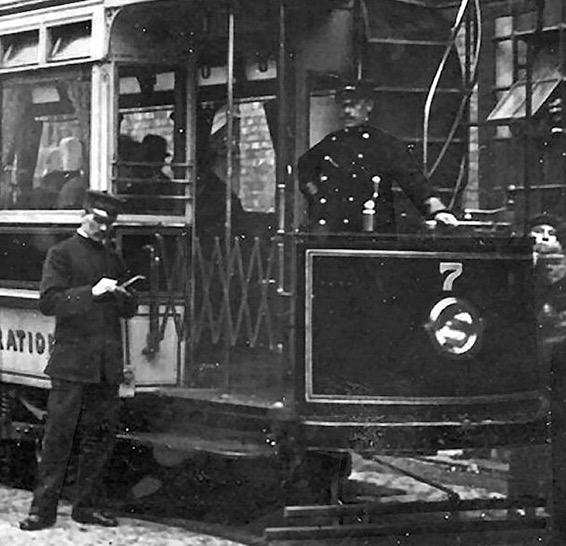
A blow-up of the above photo showing the inspector, in kepi-style cap with a pom pom and the motorman with a military-style cap.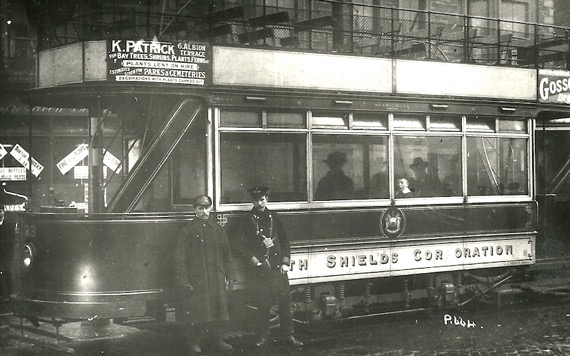
The crew of Tramcar No 23 pose for the cameraman, whose flash has been reflected by the dash — although the photo is undated, the name of the manager on the tramcar rocker panel — L E Harvey — dates it to between 1908 and 1912. Photo courtesy of the Stephen Howarth Collection.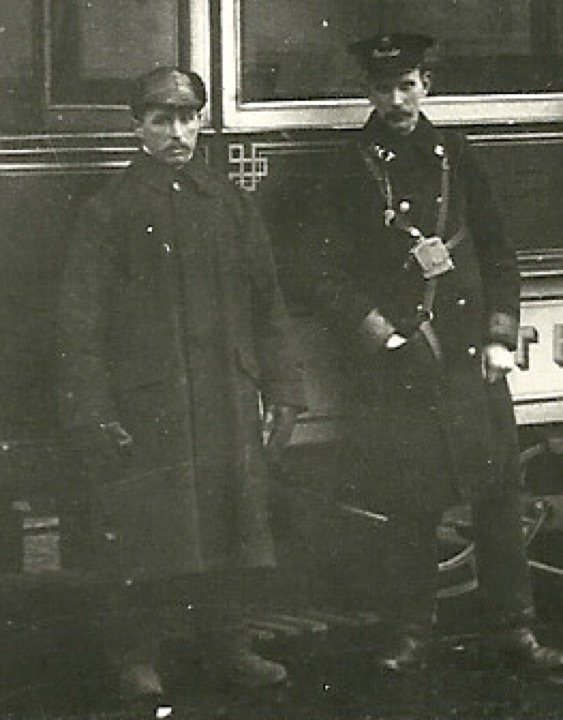
A blow up of the above photo showing the motorman, who is clearly prepared for Arctic conditions, and his conductor. The latter is wearing a round badge above his script-lettering grade badge, almost certainly of the pattern depicted below. 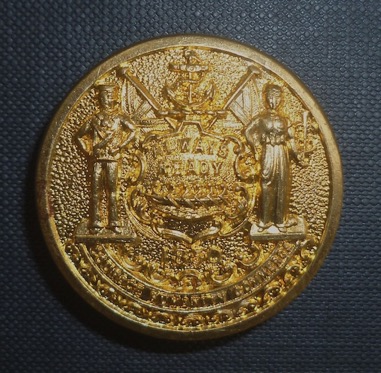
South Shields Corporation Tramways cap badge — gilt/brass. Probably used from the late Edwardian era to around the time of the Great War. Author's Collection.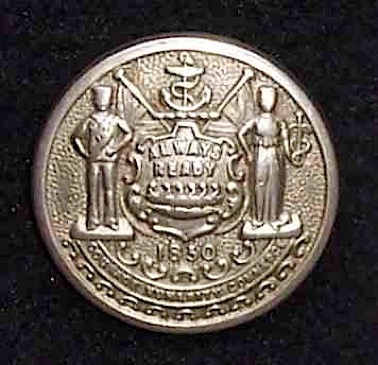
South Shields Corporation Tramways cap badge — nickel. This was probably worn from around the time of the Great War right through to closure in 1946. Author's Collection.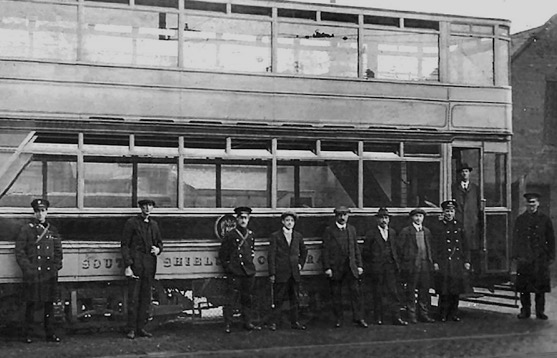
Members of staff photographed with one of the new Brush front exit tramcars (Nos 41 to 45) at Dean Road Depot in 1921. At least two of the individuals are wearing the round cap badges but without script-lettering grade badges, which appear to have been dispensed with by the end of the Great War. With thanks to Malcolm Fraser.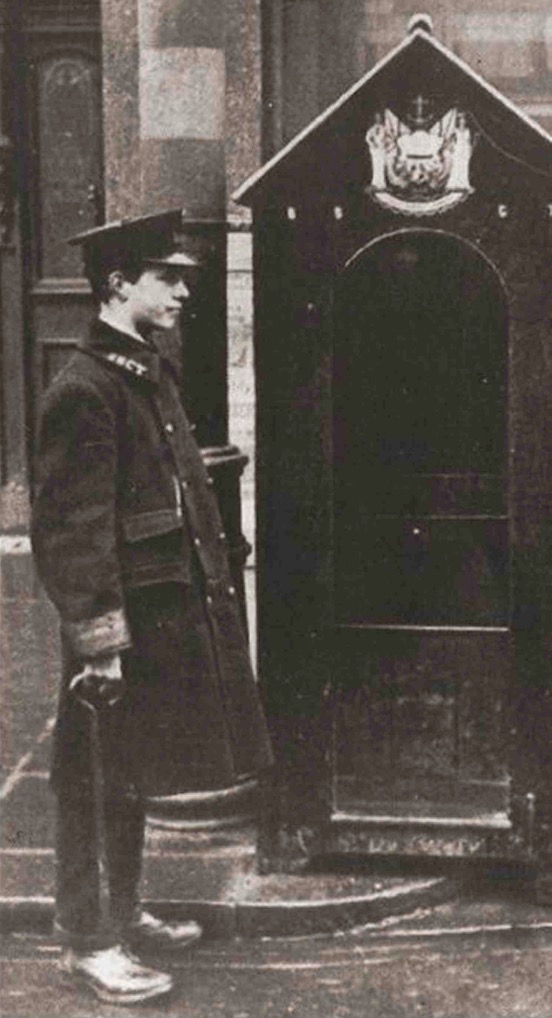
A South Shields Corporation Tramways points boy, points iron in hand — photo undated, but probably taken around 1930. The 'S S C T' collar insignia are easily made out. With thanks to Malcolm Fraser.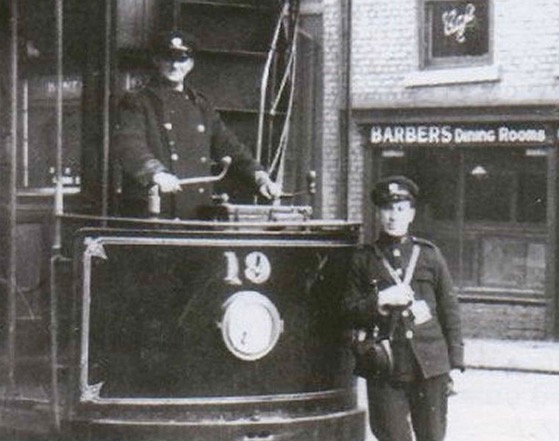
Motorman Jimmy Edwardson and conductor Frederick Boad pose with Tramcar No 19 at Slake Terrace in 1931, the latter in single-breasted jacket with upright collars and epaulettes. With thanks to Malcolm Fraser.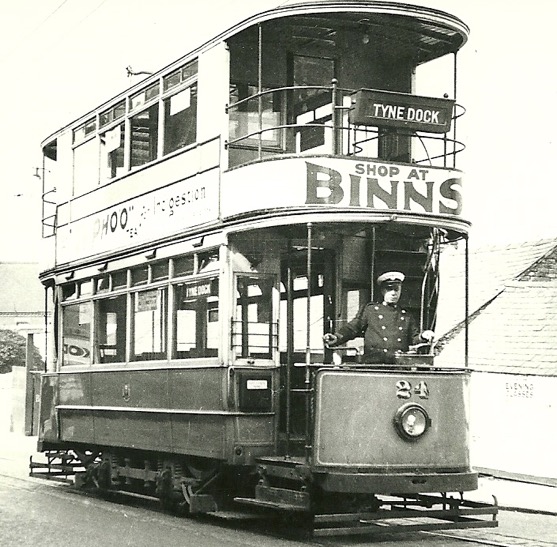
Tramcar No 24 and motorman — photo undated, but probably taken in the 1930s. Photo courtesy of the Stephen Howarth Collection.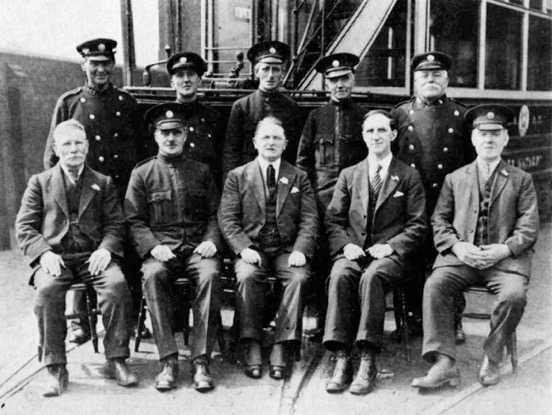
The South Shields General Manager, pictured with nine long-service employees in front of Tramcar No 13 at Dean Road Depot in 1931. From left to right, back row: P McCardle (Motorman), W Allen (Motorman), R Burford (Inspector), H Wilson (Inspector), Atkinson (Motorman); seated, W Hails (Storekeeper), W A Huntley (Chief Inspector), J Austin Baker (General Manager), J Wilson (Cashier), J Bovill (Office Caretaker). Seven of the ten individuals depicted are wearing the round municipal cap badge. With thanks to Malcolm Fraser.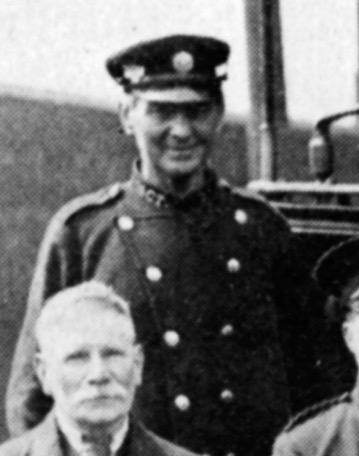
A blow-up of the above photo showing Motorman P McCardle.
Senior staff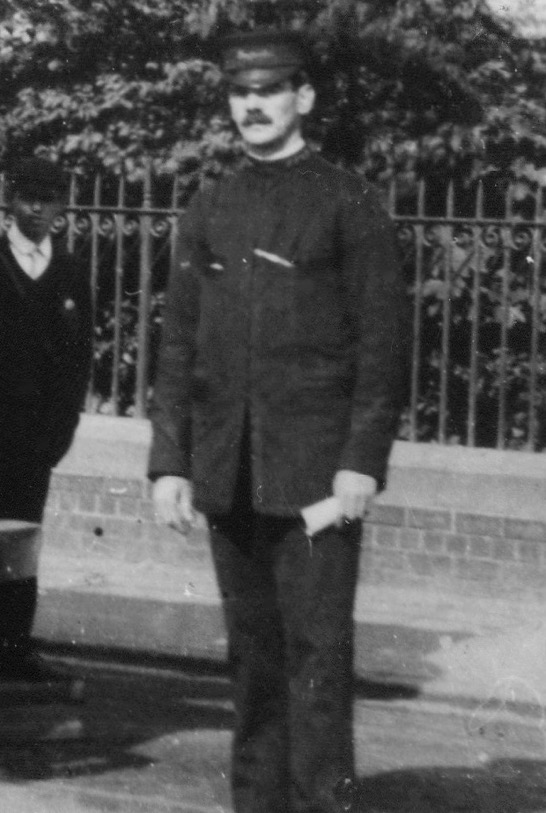
A blow-up of the photograph of Tramcar No 5 above taken in 1906, showing the inspector in his smart kepi-style cap topped off with a pom pom; the latter carries a script-lettering grade badge — Inspector — on a hat band. His left-hand collar would appear to bear embroidered 'S S C T' initials, and the right-hand side Inspector. With thanks to Malcolm Fraser.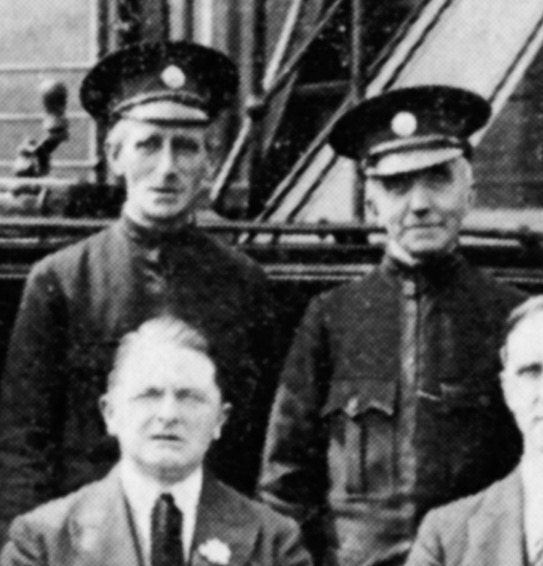
A blow-up of the 1931 long service photo above showing Inspectors Burford and Wilson. The caps do not appear to carry their grade, bearing only the standard South Shields cap badge.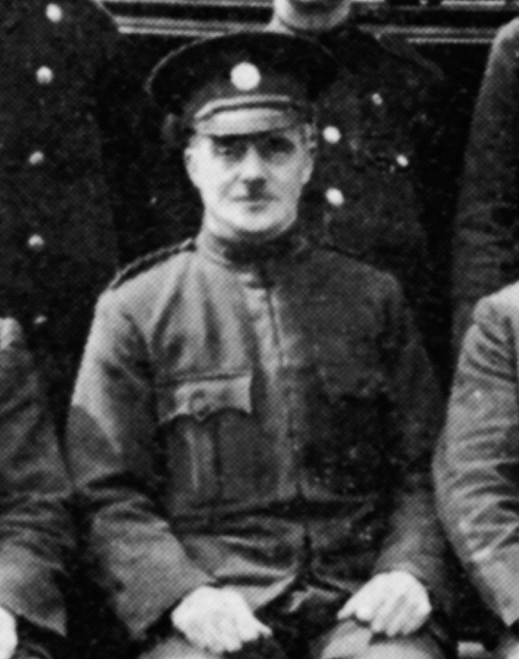
Another blow-up of the 1931 long service photo above, this time showing Chief Inspector W A Huntley. Like the inspectors above, his cap only bears the standard cap badge. The jacket epaulettes are clearly braided.
Female staff
A poor photograph, but the only one that I am aware of that shows SSCT Great War conductresses. The subjects are all wearing long, double-breasted topcoate and waterproof bonnets. The only insignia appears to be on the topcoat collars, possibly employee numbers.